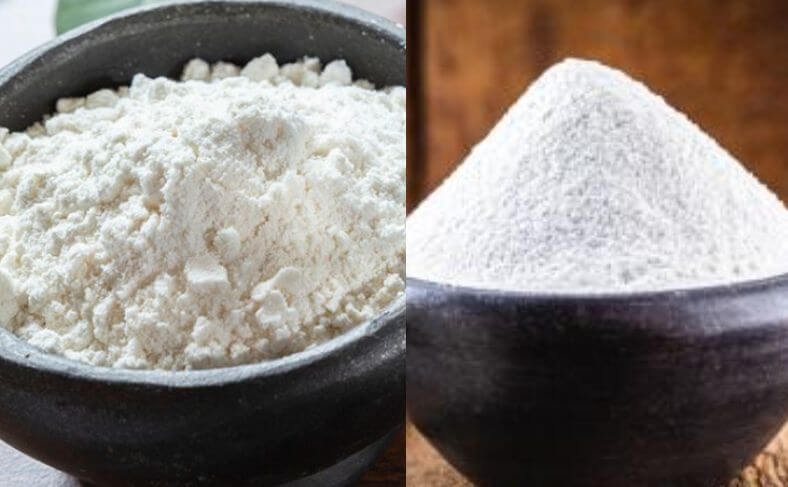Tapioca starch vs tapioca flour: Are they the same? Learn the differences, uses, and how to choose the right one for baking, cooking, or thickening your favorite recipes.
Tapioca starch and flour are often used interchangeably, but they have different properties, though derived from the same cassava root.
If you’ve ever been confused by recipes calling for one or the other, you’re not alone. While some brands label them differently, they often refer to the same ingredient.
However, in certain cases, regional processing methods or intended uses might create subtle distinctions.
Understanding these differences can help you choose the right product for thickening, baking, or gluten-free cooking.
Let’s break down why the battle of tapioca starch vs tapioca flour exists, their uses, and whether you need to pick one over the other.
Table of Contents
- What are Tapioca Starch and Tapioca Flour?
- Tapioca Starch and Flour in the Cassava Value Chain
- Tapioca Starch vs Tapioca Flour: Are There Any Differences?
- Which One Should You Use?
- Conclusion
What are Tapioca Starch and Tapioca Flour?
What is Tapioca Starch?
Tapioca starch is a fine, white powder extracted from the cassava root. The process involves washing, pulping, and pressing cassava to extract its starchy liquid.
Once the water evaporates, what’s left is a highly refined starch used as a thickener in soups, sauces, and desserts.
Uses of Tapioca Starch
- Thickening agent: Works well in soups, stews, gravies, and pie fillings.
- Gluten-free baking: Provides elasticity and chewiness to gluten-free bread and pastries.
- Tapioca pearls: Used in making boba pearls for bubble tea.
- Binding agent: Helps in creating a cohesive texture in meat or veggie patties.
- Crisping agent: Often used as a coating for fried foods to enhance crispiness.
What is Tapioca Flour?
Tapioca flour, in most cases, is another name for tapioca starch. However, some brands or regions may differentiate it based on processing methods.
Occasionally, “tapioca flour” may refer to a slightly less refined version of tapioca starch, containing more fiber and a minor difference in texture.
Uses of Tapioca Flour
- Baking: Helps improve the structure of gluten-free baked goods.
- Thickening sauces: Similar to cornstarch but with a silkier finish.
- Crispy coating: Used for making crunchy coatings for fried chicken, tempura, and other fried foods.
- Chewy texture: Common in Brazilian cheese bread (pão de queijo).
Tapioca Starch and Flour in the Cassava Value Chain
Tapioca starch and tapioca flour play important roles in the cassava value chain, with economic importance.
Both are derived from cassava and are used in various applications. Tapioca starch is ranked as the second most important commercial starch after corn starch.
It serves as a thickener, texturizer, moisture retention aid, gelling agent, adhesive, binder, film-forming agent, emulsifier, stabilizer, disintegrant, and diluent in various products.
The total demand for tapioca flour at a single factory in Indonesia is about 1000-1200 tons per month, equivalent to a cassava supply of 4000-4800 tons per month, highlighting its economic significance.
Related Posts
Industry Trends of Tapioca Starch
What is Tapioca? Types and Uses
Alternatives to Tapioca Starch
Modified Tapioca Starch: Everything to Know
How to Chemically Modify Tapioca Starch
Tapioca Starch vs Tapioca Flour: Are There Any Differences?
In most cases, tapioca starch and tapioca flour are the same product, just labeled differently.
However, depending on the brand or country of production, there may be small differences:
- Refinement level: Some brands may produce a slightly coarser version labeled as flour.
- Moisture content: Some versions of tapioca flour might contain a bit more residual moisture, making them less powdery than starch.
- Regional naming: Certain countries use “starch” for the most refined version and “flour” for a more natural, less processed form.
For practical purposes, if your package says “tapioca starch” or “tapioca flour,” you can typically use them interchangeably.
Which One Should You Use?
If you come across both tapioca starch and tapioca flour, it’s important to check the brand and intended use:
- For thickening: Either will work, but ensure it’s labeled as pure tapioca.
- For baking: Most gluten-free recipes use tapioca flour/starch interchangeably.
- For crispy coatings: Tapioca starch is often preferred because of its fine texture.
- For chewy textures: In recipes like pão de queijo, using the correct product ensures the desired chewiness.
If in doubt, check the ingredient list; if it contains only cassava-derived tapioca, it should work for all uses.
Conclusion
Tapioca starch and tapioca flour are usually the same, though minor differences can exist depending on brand and regional labeling.
Both are excellent gluten-free alternatives for baking, thickening, and frying. Whether you’re making silky sauces, chewy baked goods, or crispy fried foods, tapioca-based products can enhance your recipes.
If you’re looking for more in-depth details on their applications, check out our individual guides on tapioca starch and tapioca flour.
Understanding how to use these ingredients properly ensures better results in your cooking and baking adventures.
Now that you know the differences, which one will you try first?
- https://usflour.com/what-are-the-uses-of-tapioca-starch/
- https://www.barcelonesa.com/en/blog/best-applications-tapioca-starch/
- https://www.chagrinvalleysoapandsalve.com/collections/organic-tapioca-flour
- https://angelstarch.com/role-of-tapioca-starch-in-gluten-free-food-production/
- https://www.fao.org/4/x5032e/x5032E04.htm

Chimeremeze Emeh is a writer and researcher passionate about Africa’s most transformative root crop—cassava. Through his work at cassavavaluechain.com, he explores the entire cassava industry, from cultivation and processing to its diverse applications in food, health, and industrial use.
He also writes for palmoilpalm.com, where he shares his extensive experience and deep-rooted knowledge of palm oil, covering red palm oil, palm kernel oil, and refined products. His work there reflects his lifelong connection to agriculture and his commitment to promoting sustainable value chains in Africa.
Driven by curiosity and purpose, Chimeremeze aims to shed light on how cassava continues to empower communities, strengthen food systems, and link traditional farming wisdom with modern innovation.

